Header logo
header top contact widget
Systemic Inflammation
Avoid Dental Implant Failure
Posted on Apr 04, 2024 by William J. Claiborne, DDS MS
There are reasons to go to an expert for certain things. For example, I’d never try to do electrical work around my house on my own; I’d call an electrician.
When it comes to dental implants, there are also reasons to seek out an “expert.” In this article, I’ll explain why it’s best to have your dental implants selected and placed by a periodontist.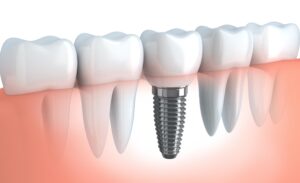
First, let’s look at the structure of an implant. Serving as a replacement for a missing tooth, the implanted portion is a titanium screw that is positioned into the jawbone. Over the course of 3-6 months, the jawbone grows around the implant, securing it in place. It can now support an artificial tooth or crown.
Dental implants have many benefits when it comes to restoring biting/chewing/speaking function and smiling appearance, including:
- enhancing the appearance of a smile
- improving biting and chewing function
- stabilizing surrounding teeth and jaw tissue
- halting the process of bone loss, known as resorption
- an increased quality of life for many people
Dental implants have an excellent success rate – 90-95%. However, there are instances where a dental implant can fail.
Dental implant complications can occur from infections, gum recession, and nerve and tissue damage. There is also a higher risk of implant failure for individuals who smoke or have diabetes, gum disease, have radiation therapy to the jaw area or take certain medications.
A periodontal specialist has advanced training and skills in the diagnosis and placement of all types of dental implants. This means that this dental specialist can determine which implant system will work best for your individual needs. For example, a person who has lost a great deal of bone mass may only be a candidate of certain implant types or may need a sinus lift prior to placement. A periodontist can make these determinations so your potential for implant success is higher.
One of the most common causes for implants failure is due to an infection at the implant site. Because a periodontist specializes in the care of gum tissues in the mouth, he or she can take measures to treat the infection at early stage to resolve the problem. However, in some cases, treating the infection may require implant removal in order to reach the infected bone tissue.
Using advanced skills, a periodontist can also assess your gum health prior to implant placement. He or she can pretreat any periodontal diseases so the implant has a healthy foundation. When the gum tissues around the implant are inflamed or have receded, the implant is at risk for entry of bacteria into the area where it is implanted.
After the implant is placed, it should fuse with the bone. A complication that prevents this may require the dental surgeon may remove it. Fortunately, after the implanted area is restored to a healthy state, the implant procedure can be redone.
Another benefit in using a periodontal specialist for implant placement is in their in-depth understanding of the nerves and tissues surrounding the jaw bones. There is a risk for failure when a dental implant is placed too close to a nerve. For example, there is a nerve that runs horizontally through the lower jaw. If the implant is placed in close proximity, it can cause numbness, tingling, or pain.
Nerve or tissue damages can result in:
-
- numbness on the side of the implant, including the lower lip and chin
- persistent pain or discomfort
- tingling, tickling, or burning sensations in the gums and skin
While precision placement (depth, position and angle) is a bonus of a periodontist’s skills for implant patients, our Asheville periodontal dental patients have the benefits of advanced technology. Our Computerized Dental Implant Placement system is designed for pre-surgical positioning of dental implants that uses a 3D model of the patient’s jaw.
Once the implant type is selected, a template is developed for optimal treatment success, even for complex cases. This minimizes disruption of gum tissues and targets implant placement at ideal depths and angles. Thus, treatment success rates are higher with faster (and more comfortable) healing time.
An example of this precision placement guidance in with upper dental implants. With declined bone mass of the upper jaw (typically from years of missing tooth roots), the sinus cavities can hover too close to the position(s) where implants are to be placed. In these cases, we can perform a sinus lift.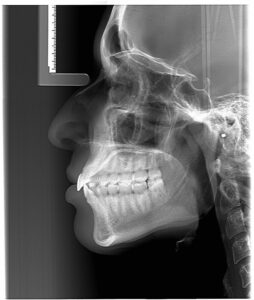
Should the dental implant protrude into the sinus cavity, the sinuses can become inflamed, causing:
- pain, tenderness, or swelling around the cheeks, eyes or forehead
- nasal blockage, often with green or yellow mucus
- a reduced sense of smell
- headaches
- toothache
- persistent bad breath
Of course, like a natural tooth, excessive force or impact can cause a dental implant to crack or become loose. For example, for people who grind or forcefully clench their teeth (“bruxing”) during sleep may need to wear a bite guard to prevent damage to the implant as well as their natural teeth.
In some instances, it can take up to 5 years for implant-related problems or infections to become apparent to the patient. Any issues that arise around the site of the dental implant should be examined and addressed without delay.
We want your dental implant(s) to last your lifetime and bring you as much eating and laughing pleasure as they are known to give. The best way to ensure the success of a dental implant is to follow the aftercare advice your periodontist and dentist provide.
As with a person’s natural teeth, an implant and the tissues surrounding it require regular cleaning. Daily flossing in the area at least once per day is needed after the gums have healed. Some patients prefer interdental brushes to access areas that are more difficult to reach.
 Regular dental check-ups and appointments for cleanings should occur at least twice a year to ensure the longterm success of your implants. Once a quarter may be advised for some individuals who have higher risks for plaque development.
Regular dental check-ups and appointments for cleanings should occur at least twice a year to ensure the longterm success of your implants. Once a quarter may be advised for some individuals who have higher risks for plaque development.
Optimal comfort for our Western Carolina patients has always been a priority. For many, a desired level of comfort and relaxation includes sedation options. Here, we offer several sedation options, including oral and IV sedation (“twilight sleep”). These are administered safely by an anesthesiologist who uses advanced safety equipment throughout your treatment.
If you are considering dental implants, you may wish to begin with a consultation appointment. During this time, we can explain the vast difference in comfort, treatment time, and success available through our specialized skills and extensive technology.
Call 828-274-9440 to schedule. New patients are always welcome.
Dental Fear Can Be Detrimental To More Than Your Smile
Posted on Feb 15, 2024 by William J. Claiborne, DDS MS
There are varying figures on the prevalence of dental fear in the U.S. However, there is no argument that it exists and affects a rather substantial number of adults.
A 2018 study shared by Dental Products Report listed the results of a study of things that keep adults from going to the dentist. Over 60% of the 18,000 polled admitted to having dental fear. Four percent shared they had never gone to a dentist as a result.
https://www.dentalproductsreport.com/view/study-finds-more-60-percent-people-suffer-dental-fear
Another study by the Cleveland Clinic stated that about 36% of people in the U.S. have a fear of dental treatment, with 12% having an extreme fear (known as “dental phobia”).
While traumatic experiences in the past (often as a child) cause some people to be fearful of dental visits, others are not aware of why or how their fears began.
The Cleveland Clinic cites the top reasons that cause people to avoid or delay dental care are:
• Fear that the anesthetic won’t be sufficient or fear of the side effects (such as numb lips) after treatment
• Fear of bleeding during a dental procedure
• Fear gagging, choking or not being able to breathe or swallow during treatment
• Fear of dentist (often due to a bad experience in the past)
• Fear of pain
• Fear of needles
• The noise made by drills or other instruments used by the dentist or hygienist
• The smells of antiseptics or other chemicals used in a dental office
https://my.clevelandclinic.org/health/diseases/22594-dentophobia-fear-of-dentists
Having the jitters at the dental office is not all that difficult to understand. During these visits, patients are positioned on their backs on a narrow recliner with a bright light shining in their faces. Add to that having to maintain an open mouth (which is full of sensitive nerves) without really knowing what is being done. It’s not surprising that there are some uneasy feelings.
Fear or anxiety are normal reactions of the brain’s “fight or flight” response. For instance, some people have an intense fear of spiders or heights. Their reactions are automatic. Yet, in many cases of dental fear, some learn to override these reactions once they develop a sense of trust in being treated gently and respectfully.
In addition to avoiding care due to fear, some of the oral health problems we see occur from:
– Insufficient oral hygiene
– Avoiding regular dental check-ups and cleanings
– Ignoring symptoms of gum disease, such as seeing blood in the sink when brushing
– Brushing too rigorously or using abrasive substances to brush
– Age-related problems, such as oral dryness
– Oral dryness due to snoring or sinus problems
– Eating a high-carb diet or snacking frequently
– Smoking (including cigarettes, vaping, marijuana, and chew)
– Regular alcohol consumption
Certainly, some people are merely more susceptible to dental decay and bacterial buildup in the mouth. It can be due to genetics or some illnesses and diseases. Yet, the majority of reasons for having oral problems can be dealt with through proper at-home care and having regular dental exams.
When dental care is delayed or avoided due to fear, small problems that could have been prevented (or easily resolved) become big problems. Big problems require more extensive procedures, more expense and more time in treatment. When dental needs become more significant, fearful patients are actually adding to their reasons to dread the dentist.
Too, when regular dental check-ups and cleanings are avoided, the result can lead to periodontal (gum) disease, which is the nation’s leading cause of adult tooth loss. Periodontal disease occurs when an over-accumulation of oral bacteria become infectious. As it penetrates gum tissues, it also attacks the bone structures underneath the gums. This disease requires treatment that is more extensive.
Additionally, tooth loss can create an entirely new set of procedural needs and costs.
For the individual who has high anxiety or fear associated with dental visits, how are they supposed to set aside these obstacles in order to receive the dental care they need? Obviously, problems in the mouth can easily exacerbate when the signs and symptoms of gum disease are back-burnered.
At our Asheville periodontal dental office, we believe that an informed patient is a healthier patient. Understanding what the problems are and what we are doing to attend to them often helps to keep the patient involved with their oral health. It also tends to help the patient relax.
As a periodontist, I feel it’s important for every adult to know the signs and symptoms of gum disease:
Gums that bleed easily
Red, swollen, tender gums
Persistent bad breath
Gums that pull away from the teeth (recede)
Changes in the way teeth fit together when biting
Changes in the fit of partial dentures
Permanent teeth that loosen or separate
When any of these emerge, prompt treatment can minimize treatment time and costs. However, ignoring the warning signs merely allows the disease to progress further – requiring more time in treatment and greater expense.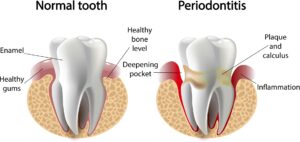
In addition to the related problems of cavities, bad breath and tooth loss, the inflammatory bacteria of gum disease can impact overall health. Years of studies have found frightening correlations between oral bacteria and the worsening or development of serious diseases.
Research has found that the oral bacteria of gum disease (which affects over 47% of the nation’s adult population) can enter the bloodstream. Once bloodborne, this bacteria has been found to trigger inflammation that has been associated with a wide range of serious health problems. Research has shown links between these infectious bacteria to heart disease, stroke, diabetes, arthritis, some cancers, preterm babies, erectile dysfunction (ED) and even Alzheimer’s disease.
I am very proud of the relationship of trust my team and I have with our patients. They know our goal is to never cause them discomfort. Although we cannot always guarantee they’ll have no discomfort at all, we take extra steps to provide optimal comfort at every visit.
In addition to this commitment, we offer oral sedation and I.V. sedation (also referred to as “twilight sleep”).
Oral sedation is a pill that helps patients relax. It also has an amnesiac effect, leaving most with little or no memory of treatment afterward. I.V. sedation places the patient in a deeper sleep state, also erasing memory of the procedure. It is administered by a doctor of anesthesiology, overseen by Dr. Brad Stone, a Medical Doctor (MD) and a board certified Anesthesiologist & Pediatric Anesthesiologist.
https://www.biltmoreperiodontics.com/comprehensive-care-team/
With both sedation options, patients are closely monitored with advanced safety equipment throughout treatment.
If fear has prevented you from a healthy smile, schedule a consultation in our Western NC periodontal dental office. During this time, we can discuss comfort options that may be best for your individual needs. Call 828-274-9440.
What Gum Disease Bacteria Does To You That May Surprise You.
Posted on Dec 15, 2023 by William J. Claiborne, DDS MS
As we round the corner of another year, making oral hygiene a priority seems a distant thought in the midst of holiday preparations and activities of the season. But, it should be at all times in our lives, for many reasons.
Over the years, research has continuously shown that the bacteria of periodontal disease can have a number of harmful effects – in the mouth AND elsewhere.
This is because these inflammatory bacteria can enter the bloodstream and travel throughout the body. Studies show that these bacteria can activate or worsen a number of serious health problems.
People easily understand that a mouthful of bacteria can cause bad breath and gums that may be tender and redden in color. This makes sense, since an area with a skin cut can redden and swell if it doesn’t heal properly. Yet, because gum tissues are concealed behind cheeks and lips, it is easier to ignore problems that may be clear that something is wrong if more exposed.
To be clear, bacteria in our bodies is not always a bad thing. For example, certain bacteria in the gut actually enhance the process of digestion and help to keep the digestive system operating efficiently.
However, some bacteria are bad. These ignite when too much bacteria invade the body, causing the immune system to become overburdened. Bacterial overload can leave the body’s natural defense response, white blood cells, unable to conquer the infection. So, when a cut becomes infected, your doctor may prescribe an antibiotic to give the immune system added reinforcements.
And, when bacteria overload occurs in the mouth, an inflammatory reaction begins. This is the beginning of gum disease.
Signs of gum disease include bleeding or sore gums, persistent bad breath, receded gums, and/or gums that are red rather than a healthy pink. These are warning signs since gum disease will only worsen without treatment.
As gum disease progresses, gums begin to pull away from the base of teeth, gums become very tender and bleed easily when brushing, pus pockets form on gums and teeth may shift or loosen.
Unfortunately, gum disease is ignored too often by adults in the U.S. The CDC estimates that over 47% of Americans have some level of gum disease, which is also the leading cause of tooth loss.
A periodontist is a specialist in the treatment of all stages of gum disease and in the placement of dental implants. He or she is the expert who can help to restore a bacteria-burdened “oral cavity” to a healthy state.
In addition to a healthy smile, the health of your gums can impact your overall health. By keeping the bacteria of advanced gum disease, known as periodontitis, you lower your risks of a long list of serious health problems that have been shown connected to gum disease bacteria. These include:
• Heart Disease & Stroke – According to research, having advanced gum disease makes you twice as likely to develop heart disease. This is due to clot-causing proteins that occur from oral bacteria that can clog arteries, including the carotid artery that supplies the brain with blood.
• Dementia & Alzheimer’s disease – Studies have shown that tooth loss from oral bacteria is a risk factor for memory loss and early stage Alzheimer’s disease. Apparently, oral infection cause inflammation triggers that can lead to the destruction of brain cells.
• Cancer – Researchers found that males with gum disease are 54% more likely to develop pancreatic cancer, nearly 50% more likely to develop kidney cancer and 30% more likely to have blood cancers.
• Diabetes – Because people with diabetes are more susceptible to infections, with 95% of whom also have periodontal disease.
• Erectile Dysfunction – Men with periodontal disease are 7 times more likely to have erectile dysfunction (ED).
• Premature Birth – Nearly 13% of U.S. babies are born premature, which can lead to breathing issues and infections. Infection in the mother’s body, which includes infection from periodontal disease, can create inflammatory reactions that are related to premature and low birth weight babies.
• Infertility – Research has found that gum disease can complicate attempts for a female to become pregnant.
• Respiratory Problems – When bloodborne bacteria from gum disease reaches the lungs, people with respiratory problems are at higher risk of pneumonia and acute bronchitis (COPD).
It has been said that the mouth is the gateway to the body. Whether it’s the holidays or vacation time or just a busy schedule, your oral health should be a commitment. It takes just minutes a day to brush your teeth thoroughly (at least 2 minutes each time), twice daily, floss daily and swish after meals.
Drink plenty of water, especially after consuming caffeinated beverages or alcohol (including wine). If you smoke, begin with a periodontal exam and ask our hygienist for at-home care instructions.
Call 828-274-9440 if you have questions about your gums or if you are experiencing any of the above mentioned symptoms of gum disease. Also, visit our website to learn more about our sedation options (including “twilight sleep”) and advanced technology, which often reduces treatment time while enhancing comfort.
Achieve Smile Goals With A Periodontist
Posted on Dec 11, 2023 by William J. Claiborne, DDS MS
If you’re like me, I’m usually looking at the end of each year feeling like there are several things I wanted to accomplish for the year, but kept putting them off until I ran out of time.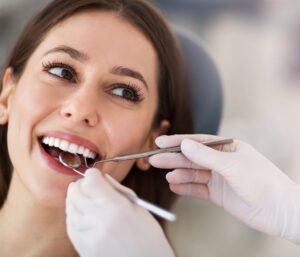
For some people, their oral health and appearance goals are on this list, with some who keep moving the goals to the next year and the next. These goals may include:
• Improving the appearance of a smile
• Having a “cleaner” mouth with fresh breath, etc.
• Replacing missing teeth
• Getting past fear or anxiety of dental visits
If you have one of these on your list, you may be surprised that a periodontal specialist can play a major role in helping you achieve your goals. And, because of the advanced skill level of a periodontist, your comfort, time in treatment and overall results can make the process easier for you.
Many general dentists and other dental specialists refer their patients to a for their specific skills. A periodontist is a dental specialist who is the expert in caring for the gum tissues in your mouth and in the placement of dental implants.
The majority of patients arrive because of periodontal (gum) disease. Common symptoms are red, swollen and tender gums. It often causes gum that bleed easily (often noticed when brushing teeth) and persistent bad breath.
Gum disease (sometimes referred to as ‘perio’ disease) only worsens without treatment. It is the leading cause of adult tooth loss. Additionally, it has been linked to the development or worsening of a long list of serious health problems elsewhere in the body.
Because the inflammatory bacteria disease can enter the bloodstream through diseased gums, their presence can activate conditions that are seemingly unrelated to oral health. Yet, the connection is severe. These health problems include stroke, heart attack, Alzheimer’s disease, dementia, preterm babies, some cancers, arthritis, diabetes, and erectile dysfunction (ED).
In our Asheville periodontal dental office, we are able to treat all stages of gum disease to restore your oral health and minimize the risk of tooth loss. For those who have developed gum disease because they’ve been afraid of dental visits, we offer oral and IV sedation (“twilight sleep”).
Sedation is administered safely by a doctor in anesthesia who uses advanced safety equipment. Our priority is always patient comfort with their safety equally so.
Too, our advanced technology is able to minimize treatment time with amazing results. For example, LANAP (Laser-Assisted New Attachment Procedure) combined with PERIOLASE MVP-7 is designed to efficiently and effectively treat periodontitis (advanced gum disease) with the advantages of a dental laser. This offers non-surgical treatment for patients with moderate to severe periodontal disease. LANAP treatment minimizes discomfort and has a quick recovery time. It has also been found to stimulate bone regrowth in damaged areas.
When tooth loss has occurred (whether from gum disease, an accident, or due to genetics), our NW NC dental specialty office also works with a number of dentists in the diagnosis and placement of dental implants.
With over 40 different implant systems, the one suited best for you depends on factors that an experienced dentist must take into consideration. For example, the number of implants you need and how much jaw bone mass exists.
For individuals who have lost a great deal of bone, specific implant types may be recommended. Some, like the “All On 4” implant system, uses specially designed implants which are placed at specific angles.
Bone loss can also be overcome by incorporating a bone rebuilding process into treatment. This is done prior to implant placement and does not require a bone graft. In many cases, we can apply a bone rebuilding material that restores ample bone mass.
The same is true when the sinus cavity will be too close to the proximity. This can be remedied through a “sinus lift.” We provide complete services of these procedures as well as dental implant placement – all performed with advanced skills and technology, such as our Cone Beam 3D imaging.
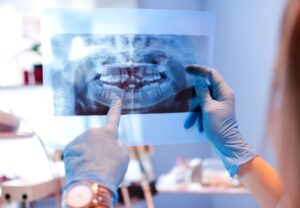 These images are ideal in diagnosis and treatment planning by giving a clear view of the mandible and maxilla (upper and lower jaw). Cone beam radiographs provide images in sagittal, axial, and coronal planes. This makes it possible to locate and trace the mandibular nerve canal for pre-surgical planning for an ideal implant position. Patients are exposed to only minute levels of radiation through a process that is fast and comfortable.
These images are ideal in diagnosis and treatment planning by giving a clear view of the mandible and maxilla (upper and lower jaw). Cone beam radiographs provide images in sagittal, axial, and coronal planes. This makes it possible to locate and trace the mandibular nerve canal for pre-surgical planning for an ideal implant position. Patients are exposed to only minute levels of radiation through a process that is fast and comfortable.
When the enhanced appearance of a smile is being sought, a periodontist also plays a part in helping to create a balanced smile line. In the procedure known as “crown lengthening,” the arch of gum tissues over teeth visible in a smile can be repositioned. This is done in a procedure known as a gingivectomy.
A gingivectomy is also performed to repair a “gummy smile.” This is when too much gum tissue shows above the teeth most visible in a smile. While the condition is not detrimental to oral health, some individuals seek to have it corrected by a periodontist.
Get the coming year started with your smile goals achieved! Call our Asheville periodontal dental office to schedule a consultation. Our friendly staff can help you arrange this private time together by calling 828-274-9440.
Recent Posts
Categories
Archives
- September 2024
- August 2024
- July 2024
- June 2024
- May 2024
- April 2024
- March 2024
- February 2024
- January 2024
- December 2023
- November 2023
- October 2023
- September 2023
- August 2023
- July 2023
- June 2023
- May 2023
- April 2023
- March 2023
- February 2023
- January 2023
- December 2022
- November 2022
- October 2022
- September 2022
- August 2022
- July 2022
- June 2022
- May 2022
- April 2022
- March 2022
- February 2022
- January 2022
- December 2021
- November 2021
- October 2021
- September 2021
- August 2021
- July 2021
- June 2021
- May 2021
- April 2021
- March 2021
- February 2021
- January 2021
- December 2020
- November 2020
- October 2020
- September 2020
- August 2020
- July 2020
- June 2020
- May 2020
- April 2020
- March 2020
- February 2020
- January 2020
- December 2019
- November 2019
- October 2019
- September 2019
- August 2019
- July 2019
- June 2019
- May 2019
- April 2019
- March 2019
- February 2019
- January 2019
- December 2018
- November 2018
- October 2018
- September 2018
- August 2018
- July 2018
- June 2018
- May 2018
- April 2018
- March 2018
- February 2018
- January 2018
- December 2017
- November 2017
- October 2017
- September 2017
- August 2017
- July 2017
- June 2017
- May 2017
- April 2017
- March 2017
- February 2017
- January 2017
- December 2016
- November 2016
- October 2016
- September 2016
- August 2016
- July 2016
- June 2016
- May 2016
- April 2016
- March 2016
- February 2016
- January 2016
- December 2015
- November 2015
- October 2015
- September 2015
- August 2015
- July 2015
- June 2015
- May 2015
- April 2015
- March 2015
- February 2015
- January 2015
- December 2014
- November 2014
- October 2014
- September 2014
- August 2014
- July 2014
- June 2014
- May 2014
- April 2014
- March 2014
- February 2014
- January 2014
- December 2013
- November 2013
- October 2013
- September 2013
- August 2013
- July 2013
- June 2013
- May 2013
- April 2013
- March 2013
- February 2013
- January 2013
- December 2012
- November 2012
- October 2012
- September 2012
- August 2012
- July 2012
- June 2012


